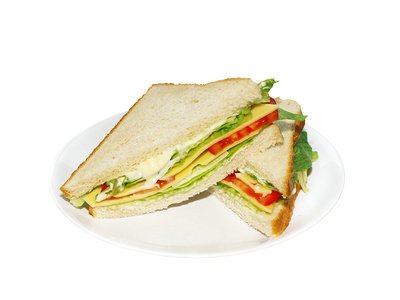Running on Empty: The New and “Improved” School Lunch

I used to love school lunches. Seriously, I did! Our school had a main dish called Flying Saucer. It was a slice of ham, topped with a scoop of mashed potatoes, and smother in a creamy cheese sauce. Delicious.
And where you sat was just as important as what you were served. We all know our friends’ preferences. Sit by Jane on PBJ day because she would trade her sandwich for your carrot sticks and dip. Or Bobby would swap tater tots for chicken nuggets.
Now? You couldn’t pay me money to eat school lunch.
What the Heck Happened?!
The Healthy, Hunger-Free Kids Act, that’s what happened. The U.S. Department of Agriculture handed down this ridiculous mandate and put it into effect September, 2012.
Here is a breakdown of the program.
Portions are controlled for fruits, vegetables, grains, and protein. While there is strict maximum serving size for grains and proteins – you know, the foods that make you feel full – there are no maximums for fruits and vegetables.
There are minimums for the produce items though. Check out the serving sizes for each age range. Each student must be served at least this much for both fruits and vegetables.
- Elementary school students – ½ cup
- Grades six through eight – ¾ cup
- High school students – 1 cup
This is the first program in history to include a calorie cap on each meal. Younger kids can be served a maximum of 650 calories per meal. How much do older kids get? 850 calories.
Want a reference point? Your average ¼ pound hamburger served plain is almost 500 calories. If schools don’t adhere to the calorie count, the district will receive less federal money the following year.
In addition to monitoring portion sizes and calories consumed, meals must cut back on sodium, fats and carbs.
And, this menu is mandatory in all public schools.
What it Means
First of all, it means you’ll never find me working food service in a public school. I’m surprised those little old ladies aren’t equipped with riot gear. Portions must be consistent for everyone. That means the burly football player is getting the same amount of food as the petite cheerleader. And – get this – high school seniors are served two ounces more protein than kindergarteners.
It also means that kids are eating less food. Milk is included in the calorie count. And at some point during the week, the fruit and vegetable offering must be red or orange. “Yum. Beets,” said no kindergartener ever. Considering many children from low-income families only get one good meal per day, it means they are forced to eat this junk or starve to death. And from the sounds of it, even if they do eat the entire meal, they are still starving.
What else does it mean? It means schools can no longer offer many of the student’s favorite condiments. Because of the high sodium content, students can have a single packet of ketchup. And to make sure the kids only take one, there is someone standing there, monitoring the students’ activity. That sounds like an amazing use of time and money, by the way. Similarly, all these marvelous, tasty vegetables are served without salt. Raw vegetables aren’t accompanied by any dip or sauce. Sounds tasty, right?
And it means a lot of money is going in the trash. Go to your kitchen cupboard right now and look at your measuring cups. A 5-year old is expected to eat ½ cup fruit and ½ cup vegetables? And what high schooler wants to sit down and munch on a full cup of raw celery? All that extra food is going in the trash. Meanwhile, more and more kids are bringing a sack lunch. In one school, over half the student population now brings food from home. However, the school still needs to prepare enough meals to feed those kids – regardless of the fact they bring their own. So all that food is going in the trash too – leftovers are illegal.
Worst of all, it means the kids with the lowest self-esteem of all are being badgered even more. Rich kids who are still hungry simply go buy a second (or third) meal. After a poor kid snarfs down his meal, he has to sit quietly and watch everyone else eat a second hamburger. This program was implemented to combat childhood obesity. Everyone knows that. So the fit kids are mocking the heavier kids, making comments like, “It’s your fault everyone in school is hungry.”
Nice, right?
Do We Even Want to Ask What the Future Holds?!
New regulations for school breakfasts go into effect with the 2013-2014 school year. If kids weren’t hungry before, they will be in the future.
The Healthy, Hunger-Free (yeah right!) Kids Act is the first major change to affect school lunch in 15 years. It seems they went from one extreme to the other. Instead of making gradual changes, the federal government pulled the rug out from underneath everyone over night.
What are your thoughts? Has the USDA gone too far? Do the pros outweigh the cons or vice versa? Would you eat that rabbit food they are serving now?





